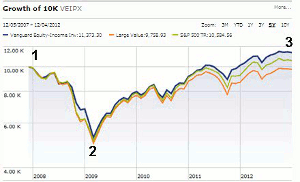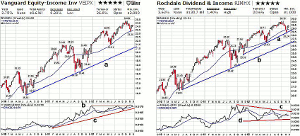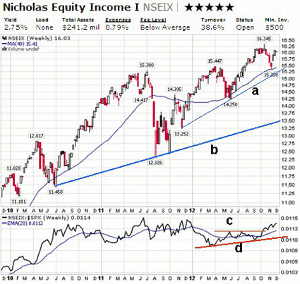With so many companies either declaring special dividends or moving up their ex-dividend date in an effort to beat the taxman should we go over the fiscal cliff, MoneyShow’s Tom Aspray takes a look at top-performing equity-income funds, which can provide alternatives to investing in specific income-producing stocks.
The stampede out of dividend paying stocks started in the middle of October, and in hindsight, was probably the most accurate poll of how the election would turn out. The slide was well underway when Barron’s cover story Best 25 Dividend Funds was released on November 5. The subscriber-only article discusses the recent popularity of these funds, ranks the top 25 by three-year returns, and interviews several of the managers.
For those who do not have the time or capital to invest in a group of income-producing stocks, these can be an attractive alternative. If you are confident about the overall direction of the stock market, they can be used as a diversified way to boost the return of your portfolio.
It is important that you do your research as the managers of these funds often employ quite different styles. Some mangers invest only in large caps, others favor mid caps and some look overseas. Morningstar.com is one of the best places to do your research as they provide a wealth of information for free and even more in their premium services.
It is important that if you are considering any of these funds that you look at their historical price volatility. This chart from Morningstar features Vanguard Equity Income Inc. (VEIPX) and tracks the value of $10,000 invested at the start of 2008 (point 1). The chart shows the steady decline into early 2009 as the fund lost close to 50% of its value (point 2). Of course, it was clear from a technical perspective by early in 2008 that we were in a bear market so this was not the time to invest.
One should also note that the $10,000 investment is now back to $12,000 (point 3). I have selected four no-load funds from the list as in my opinion there is no justification for paying 5% or more upfront to purchase any fund. Today’s charts come from StockCharts.com using the relative performance analysis that I explained in “Learn to Drive Your Own 401k”. Comparing these funds to the performance of the S&P 500 or Spyder Trust (SPY) can help you find the top funds.
Chart Analysis: Vanguard Equity Income Inc. (VEIPX) is the third best fund in Barron’s ranking with a three year total return of 15.3%. I have also included some pertinent data from Morningstar above the chart showing that VEIPX yields 2.75%, expenses of 0.30%, a minimum investment of $3000, and is a five-star fund.
- There is an incredible amount of data on their site including a detailed analysis of each fund’s main holdings—take a look.
- The chart shows a well-defined uptrend, line a, from the 2010 lows as it connects the major lows of $15.88 and $18.18.
- The sharp correction from the 2011 high at $21.51 to the low of $18.18 held just above the 61.8% Fibonacci retracement support at $18.03.
- The correction in early 2012 retraced 36% of the prior rally as VEIPX found support at the rising 40-week MA.
- In October, the high was $24.80, and the low three weeks ago was $23.21, which was a 48% retracement of the prior rally. It also held the 40-week MA.
- This is a now an important level and should be used for a stop on new positions.
- The long-term pattern of the ratio or RS line shows a clear long term uptrend, line c.
- The resistance at line b was overcome in late October and the breakout level is now being retested.
- The next resistance is at $24.80 and a rally from the recent lows that was equal to the rally from the June lows would take VEIPX to $26.50.
The Rochdale Dividend & Income (RIMHX) is a large value fund, yielding 3.63%, which has relatively high expenses of 1.40%. It has a lower minimum investment of $1,000 and is also a five-star fund. Its major holdings are quite different from those of VEIPX.
- The recent rally has taken the fund 4% from the recent low at $28.24 with the 40-week MA at $28.87.
- The recent correction retraced just over 50% of the prior rally, but held the near-term uptrend, line d.
- The longer-term uptrend, line e, and the early 2012 lows are in the $26.50-$27.03 area.
- The relative performance or RS analysis has been in a broad trading range for much of 2012, lines f and g.
- The ratio line is close to moving above its EMA, which may be sign that 2013 will be a good year for RIMHX.
- The fund has underperformed the S&P 500 by about 7% so far in 2012 but it outperformed the S&P by the same amount in 2011.
- Once above the resistance in the $30 area, the 127.2% Fibonacci target is at $30.60 with equality targets at $31.34.
NEXT PAGE: Two Market Leading Funds
|pagebreak|The Nicholas Equity Income I (NSEIX) is a mid-cap value five-star fund that yields 2.75% with expenses of 0.79% and a low minimum of $500.
- The recent correction retraced just under 50% of the recent rally and tested the 40-week MA.
- The correction held well above the near-term uptrend, line a, which is currently at $15.18.
- There is long-term support, line b, in the $13.50 area.
- The relative performance ratio broke through resistance, line c, in October and completed the bottom formation (line d).
- The ratio line is rising strongly as NSEIX is up over 4% above the recent lows.
- The last two major rallies have been around $2.20 so the next reasonable target is in the $17.40 area.
- A close under the 40-week MA would be negative.
T. Rowe Price Equity Income (PRFDX) is a four-star, large-cap value fund that yields 2.03% with expenses of 0.68%. It is one of the largest funds in this category with over $24 billion. It has a minimum investment of $2,500. It holds many of the best known large-cap stocks.
- The daily chart shows that PRFDX broke through long-term resistance, line e, in September.
- The correction into the November lows held the 40-week MA and the long-term uptrend, line f. The correction retraced 44% of the previous rally.
- The ratio line broke through 16-month resistance, line g, in July and PRFDX has gained over 6% since.
- This completed a long-term base formation, line h.
- The ratio has recently turned up sharply and is well above its rising WMA.
- Once above the previous high at $28.64 the 127.2% Fibonacci target is at $27.30.
What it Means: This discussion of these four no-load, dividend or equity income funds shows you why they can be a viable for those who do not have the time or capital to follow my individual stock recommendations. They also gave me the opportunity to show you the many benefits of two great research sites, Morningstar and Stockcharts.
Of the four funds, I like Nicholas Equity Income I (NSEIX) and T. Rowe Price Equity Income (PRFDX) the best because of their strong relative performance analysis. Those who are interested should know that the minimums are often smaller for IRA accounts, and they allow for much small subsequent investments.
As I discussed last week, buying at strong resistance is not being a smart buyer. Therefore, for establishing a position in these funds, I would spread my purchases out over the next few months (dollar cost averaging) after the initial investment, as the market is now near strong resistance.
How to Profit: For those buying the Nicholas Equity Income I (NSEIX), use a weekly close-only stop at $15.29.
For those buying the T. Rowe Price Equity Income (PRFDX), use a weekly close-only stop at $24.97.






















